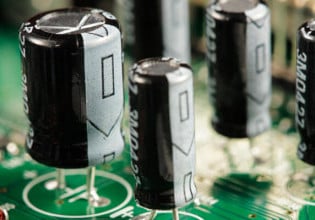SiC Tech Enables High-Frequency Battery Charging for Material Handling Equipment
Navitas Semiconductor has announced that Exide Technologies will use Navitas GeneSiC MOSFETs and Schottky diodes in its next-generation battery fast-charging platform for material handling equipment.
Navitas Semiconductor has announced that Exide Technologies will use Navitas GeneSiC technology in its high-frequency fast-charging platform for industrial material handling equipment.
Aisle truck for material handling. Image used courtesy of Exide Technologies
The fast charger is designed to rapidly charge the lead-acid and lithium-ion powertrain batteries used in material handling equipment like forklifts, pallet trucks, and automated guided vehicles (AGVs).
Exide has chosen Navitas technology for its reliability, safety, and ease of use and to optimize the performance of its high-frequency charging platform.
Mobile Platforms to Move Materials
Industrial material handling vehicles are small, mobile battery-powered platforms like forklifts and pallet trucks used to move heavy materials and inventory.
More recently, automated guided vehicles (AGV) have emerged with capabilities similar to traditional forklifts and pallet trucks but designed with technology that allows them to operate autonomously without a human driver.
These small but powerful, electric-powered vehicles are typically powered by lead-acid or lithium-ion batteries that must be recharged. Unlike EVs, these smaller platforms are designed to operate in a relatively small factory or warehouse and are not required to travel long distances. Their proximity to a charge source during operation greatly simplifies powertrain system design requirements.
Autonomous material handling vehicle. Image used courtesy of Exide Technologies
Fast-Charging Solution for Material Handling Equipment
Exide’s new high-frequency, fast-charging solution is designed to convert 220 VAC power to a battery level voltage between 24 VDC and 80 VDC capable of recharging a material handling vehicle's lead-acid or lithium-ion powertrain battery.
Each charging module will deliver up to 7 kW of charge power, with the ability to upgrade to 10 kW. Four modules can be combined to achieve 40 kW of charging power in a single unit.
Exide’s current 2100 series of chargers can deliver up to 300 A of charge current. Multiple chargers can be operated in a single network and integrated with battery monitoring software for a complete fleet management solution.
Fleet management charger network. Image used courtesy of Exide Technologies
Navitas GeneSiC Technology
The new high-frequency charger will use GeneSiC G3R60MT07D (750 V) MOSFETs and GD10MPS12A (1200 V) MPS Schottky diodes in a frequency-optimized rectifier architecture to convert AC line power to DC for powertrain battery charging.
GeneSiC devices are constructed from wide bandgap silicon carbide (SiC) materials that allow them to perform better than traditional silicon at higher voltages, temperatures, and frequencies. The devices incorporate “trench assisted planar-gate” technology that helps with performance and efficiency at higher switching speeds while leveraging lower-cost manufacturing techniques.
GeneSiC operates cooler at high frequency. Image used courtesy of Navitas
According to Navitas, GeneSiC devices can operate up to three times longer than comparable SiC devices due to their cooler operating temperatures and offer up to 50% longer short-circuit withstand times.
GeneSiC short-circuit withstand time. Image used courtesy of Navitas
Navitas Semiconductor Added to Russell 3000 Index
In other news, Navitas Semiconductor has announced that effective Monday, June 26, the company will be added as a member of the broad market Russell 3000 Index. The inclusion is part of the 2023 restructuring of the equity index and a vote of confidence for the company, whose performance will now be representative of the broader stock market.
As of market close on May 23, 2023, Navitas Semiconductor had a market capitalization of ~ $1.5 billion.











